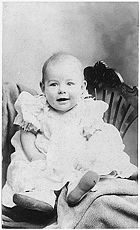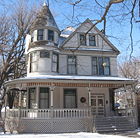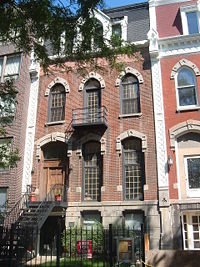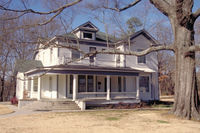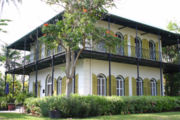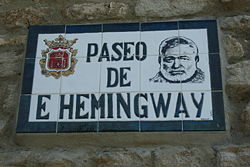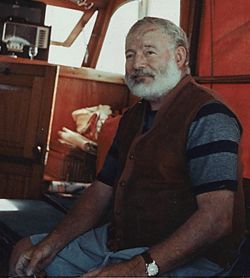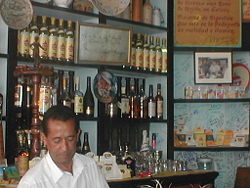Ernest Hemingway
2008/9 Schools Wikipedia Selection. Related subjects: Writers and critics
| Ernest Hemingway | |
|---|---|
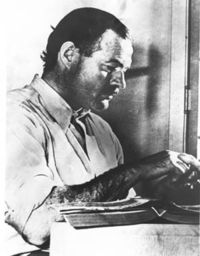 Hemingway in 1939 |
|
| Born | July 21, 1899 Oak Park, Illinois, United States |
| Died | July 2, 1961 (aged 61) Ketchum, Idaho, United States |
| Occupation | Author, Novelist, Journalist |
| Nationality | American |
| Genres | War, Romance |
| Literary movement | The Lost Generation |
| Notable award(s) | Nobel Prize in Literature 1954 |
| Spouse(s) | Elizabeth Hadley Richardson (1921-1927) Pauline Pfeiffer (1927-1940) Martha Gellhorn (1940-1945) Mary Welsh Hemingway (1946-1961) |
| Children | Jack Hemingway (1923-2000) Patrick Hemingway (1928-) Gregory Hemingway (1931-2001) |
|
Influences
|
|
|
Influenced
|
|
Ernest Miller Hemingway ( July 21, 1899 — July 2, 1961) was an American novelist, short-story writer, and journalist. He was part of the 1920s expatriate community in Paris, and one of the veterans of World War One later known as "the Lost Generation," a term Gertrude Stein used according to his posthumous memoir A Moveable Feast. ("'That's what you are. That's what you all are,' Miss Stein said. 'All of you young people who served in the war. You are a lost generation.'" Stein had overheard a garage owner use the phrase to criticize a mechanic.) He received the Pulitzer Prize in 1953 for The Old Man and the Sea, and the Nobel Prize in Literature in 1954.
Hemingway's distinctive writing style is characterized by economy and understatement, in contrast to the style of his literary rival William Faulkner. It had a significant influence on the development of twentieth-century fiction writing. His protagonists are typically stoic men who exhibit an ideal described as "grace under pressure." Many of his works are now considered basic classics of American literature.
Biography
Early life
Ernest Miller Hemingway was born on 21 July 1899 in Oak Park, Illinois, a suburb of Chicago. Hemingway was the first son and the second child born to Clarence Edmonds "Doc Ed" Hemingway - a country doctor, and Grace Hall Hemingway. Hemingway's father attended the birth of Ernest and blew a horn on his front porch to announce to the neighbors that his wife had given birth to a boy. The Hemingways lived in a six-bedroom Victorian house built by Ernest's widowed maternal grandfather, Ernest Miller Hall, an English immigrant and Civil War veteran who lived with the family. Hemingway was his namesake.
Hemingway's mother once aspired to an opera career and earned money giving voice and music lessons. She was domineering and narrowly religious, mirroring the strict Protestant ethic of Oak Park, which Hemingway later said had "wide lawns and narrow minds". His mother had wanted twins, and when this did not happen, she dressed young Ernest and his sister Marcelline (eighteen months older) in similar clothes and with similar hairstyles, maintaining the pretense of the two children being "twins." Some biographers have suggested that Grace Hemingway further "feminised" her son in his youth by calling him "Ernestine", but male infants and toddlers of the Victorian middle-class were often dressed as females. Many themes in Hemingway's work point to destructive interactions between male and female sexual partners (cf. " Hills Like White Elephants"), within marital unions (cf. " Now I Lay Me", " The Short Happy Life of Francis Macomber"), and among most other combinations of men and women (cf. The Sun Also Rises); in addition certain posthumously published pieces contain ambiguous treatment of gender roles. However, no connection between Hemingway's depiction of these human conditions and his own early childhood experiences has been established.
While his mother hoped that her son would develop an interest in music, Hemingway adopted his father's outdoorsman hobbies of hunting, fishing and camping in the woods and lakes of Northern Michigan. The family owned a house called Windemere on Michigan's Walloon Lake and often spent summers vacationing there. These early experiences in close contact with nature instilled in Hemingway a lifelong passion for outdoor adventure and for living in remote or isolated areas.
Hemingway attended Oak Park and River Forest High School from September, 1913 until graduation in June 1917. He excelled both academically and athletically; he boxed, played American football, and displayed particular talent in English classes. His first writing experience was writing for "Trapeze" and "Tabula" (the school's newspaper and yearbook, respectively) in his junior year, then serving as editor in his senior year. He sometimes wrote under the pen name Ring Lardner, Jr., a nod to his literary hero Ring Lardner.
After high school, Hemingway did not want to go to college. Instead, at age eighteen, he began his writing career as a cub reporter for The Kansas City Star. Although he worked at the newspaper for only six months ( October 17, 1917- April 30, 1918), throughout his lifetime he used the guidance of the Star's style guide as a foundation for his writing style: "Use short sentences. Use short first paragraphs. Use vigorous English. Be positive, not negative." In honour of the centennial year of Hemingway's birth (1899), The Star named Hemingway its top reporter of the last hundred years.
World War I
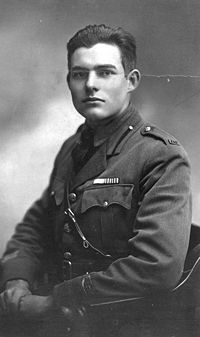
Hemingway left his reporting job after only a few months and, against his father's wishes, tried to join the United States Army to see action in World War I. He failed the medical examination due to poor vision, and instead joined the Red Cross Ambulance Corps. On his route to the Italian front, he stopped in Paris, which was under constant bombardment from German artillery. Instead of staying in the relative safety of the Hotel Florida, Hemingway tried to get as close to combat as possible.
Soon after arriving on the Italian Front Hemingway witnessed the brutalities of war. On his first day on duty an ammunition factory near Milan blew up. Hemingway had to pick up the human—primarily female—remains. Hemingway wrote about this experience in his short story " A Natural History of the Dead". This first encounter with death left him shaken.
The soldiers he met later did not lighten the horror. One of them, Eric Dorman-Smith, entertained Hemingway with a line from Part Two of Shakespeare's Henry IV, Act III, Scene II: "By my troth, I care not; a man can die but once; we owe God a death...and let it go which way it will, he that dies this year is quit for the next." (Hemingway, for his part, would quote this line in " The Short Happy Life of Francis Macomber", one of his famous short stories set in Africa.) To another soldier, Hemingway once said, "You are troppo vecchio ( It. too old) for this war, pop." The 50-year old soldier replied, "I can die as well as any man."
On 8 July 1918, Hemingway was wounded delivering supplies to soldiers, which ended his career as an ambulance driver. He was hit by an Austrian trench mortar shell that left fragments in his legs, and was also hit by a burst of machine-gun fire. He was later awarded the Silver Medal of Military Valor (medaglia d'argento) from the Italian government for dragging a wounded Italian soldier to safety in spite of his own injuries. He was credited as the first American wounded in Italy during WWI by newspapers at the time but there is debate surrounding the veracity of this claim.
Hemingway received treatment in a Milan hospital run by the American Red Cross. With very little in the way of entertainment, he often drank heavily and read newspapers to pass the time. Here he met Agnes von Kurowsky of Washington, D.C., one of eighteen nurses attending groups of four patients each, who was more than six years his senior. Hemingway fell in love with her, but their relationship did not survive his return to the United States; instead of following Hemingway to America, as originally planned, she became romantically involved with an Italian officer. This left an indelible mark on his psyche and provided inspiration for, and was fictionalized in, one of his early novels, A Farewell to Arms. Hemingway's first story based on this relationship, "A Very Short Story," appeared in 1925.
First novels and other early works
After the war, Hemingway returned to Oak Park, and in 1920, he moved to an apartment on 1599 Bathurst Street, now known as The Hemingway, in the Humewood-Cedarvale neighbourhood in Toronto, Ontario. During his stay, he found a job with the Toronto Star newspaper. He worked as a freelancer, staff writer, and foreign correspondent. Hemingway befriended fellow Star reporter Morley Callaghan. Callaghan had begun writing short stories at this time; he showed them to Hemingway, who praised them as fine work. They would later be reunited in Paris.
For a short time from late 1920 through most of 1921, Hemingway lived on the near north side of Chicago, while still filing stories for The Toronto Star. He also worked as associate editor of the Co-operative Commonwealth, a monthly journal. On September 3rd, 1921, Hemingway married his first wife, Hadley Richardson. After the honeymoon they moved to a cramped top floor apartment on the 1300 block of Clark Street. In September, he moved to a cramped fourth floor apartment (3rd floor by Chicago building standard) at 1239 North Dearborn in a then run-down section of Chicago's near north side. The building still stands with a plaque on the front of it calling it "The Hemingway Apartment." Hadley found it dark and depressing, but in December, 1921, the Hemingways left Chicago and Oak Park, never to live there again, and moved abroad.
At the advice of Sherwood Anderson, they settled in Paris, France, where Hemingway covered the Greco-Turkish War for the Toronto Star. Anderson gave him a letter of introduction to Gertrude Stein. She became his mentor and introduced him to the "Parisian Modern Movement" then ongoing in the Montparnasse Quarter; this was the beginning of the American expatriate circle that became known as the " Lost Generation", a term popularized by Hemingway in the epigraph to his novel, The Sun Also Rises, and his memoir, A Moveable Feast. The epithet, "Lost Generation" was reportedly appropriated by Miss Stein from her French garage mechanic when he made the offhand comment that hers was "une generation perdue". His other influential mentor was Ezra Pound, the founder of imagism. Hemingway later said of this eclectic group, "Ezra was right half the time, and when he was wrong, he was so wrong you were never in any doubt about it. Gertrude was always right." The group often frequented Sylvia Beach's bookshop, Shakespeare & Co., at 12 Rue de l'Odéon. After the 1922 publication and American banning of colleague James Joyce's Ulysses, Hemingway used Toronto-based friends to smuggle copies of the novel into the United States (Hemingway writes of meeting and talking with Joyce in Paris in A Moveable Feast). His own first book, called Three Stories and Ten Poems (1923), was published in Paris by Robert McAlmon.
After much success as a foreign correspondent, Hemingway returned to Toronto, Canada in 1923. During his second stint living in Toronto, Hemingway's first son was born. He was named John Hadley Nicanor Hemingway, but would later be known as Jack. Hemingway asked Gertrude Stein to be Jack's godmother.
Around the same time, Hemingway had a bitter falling out with his editor, Harry Hindmarsh, who believed Hemingway had been spoiled by his time overseas. Hindmarsh gave Hemingway mundane assignments, and Hemingway grew bitter and wrote an angry resignation in December 1923. However, his resignation was either ignored or rescinded, and Hemingway continued to write sporadically for The Toronto Star through 1924. Most of Hemingway's work for the Star was later published in the 1985 collection Dateline: Toronto.
Hemingway's American literary debut came with the publication of the short story cycle In Our Time (1925). The vignettes that now constitute the interchapters of the American version were initially published in Europe as in our time (1924). This work was important for Hemingway, reaffirming to him that his minimalist style could be accepted by the literary community. " Big Two-Hearted River" is the collection's best-known story.
In April 1925, two weeks after the publication of The Great Gatsby, Hemingway met F. Scott Fitzgerald at the Dingo Bar. Fitzgerald and Hemingway were at first close friends, often drinking and talking together. They sometimes exchanged manuscripts, and Fitzgerald tried to do much to advance Hemingway's career and the publication of his first collections of stories.
Hemingway's relationships in France provided inspiration for Hemingway's first full-length novel, The Sun Also Rises (1926) (published in the U.K. under the title "Fiesta"). The novel was semi-autobiographical, following a group of expatriate Americans around Paris and Spain. The climactic scenes of the novel are set in Pamplona, during the fiesta that the novel made famous throughout Europe and the U.S. The novel was a success and met with critical acclaim. While Hemingway had initially claimed that the novel was an obsolete form of literature, he was apparently inspired to write it after reading Fitzgerald's manuscript for The Great Gatsby.
Hemingway divorced Hadley Richardson in 1927 and married Pauline Pfeiffer, a devout Roman Catholic from Piggott, Arkansas. Pfeiffer was an occasional fashion reporter, publishing in magazines such as Vanity Fair and Vogue. Hemingway converted to Catholicism himself at this time. That year saw the publication of Men Without Women, a collection of short stories, containing The Killers, one of Hemingway's best-known and most-anthologized stories. In 1928, Hemingway and Pfeiffer moved to Key West, Florida, to begin their new life together. However, their new life was soon interrupted by yet another tragic event in Hemingway's life.
In 1928, Hemingway's father, Clarence, troubled with diabetes and financial instabilities, committed suicide using an old Civil War pistol. This greatly hurt Hemingway and is perhaps played out through Robert Jordan's father's suicide in the novel For Whom the Bell Tolls. He immediately traveled to Oak Park to arrange the funeral and stirred up controversy by vocalizing what he thought to be the Catholic view, that suicides go to Hell. At about the same time, Harry Crosby, founder of the Black Sun Press and a friend of Hemingway's from his days in Paris, also committed suicide.
In that same year, Hemingway's second son, Patrick, was born in Kansas City (his third son, Gregory, would be born to the couple a few years later). It was a Caesarean birth after difficult labor, details of which were incorporated into the concluding scene of A Farewell to Arms. Hemingway lived and wrote most of A Farewell to Arms plus several short stories at Pauline's parents' house in Piggott, Arkansas. The Pfeiffer House and Carriage House has since been converted into a museum owned by Arkansas State University.
Published in 1929, A Farewell to Arms recounts the romance between Frederic Henry, an American soldier, and Catherine Barkley, a British nurse. The novel is heavily autobiographical: the plot was directly inspired by his relationship with Agnes von Kurowsky in Milan; Catherine's parturition was inspired by the intense labor pains of Pauline in the birth of Patrick; the real-life Kitty Cannell inspired the fictional Helen Ferguson; the priest was based on Don Giuseppe Bianchi, the priest of the 69th and 70th regiments of the Brigata Ancona. While the inspiration of the character Rinaldi is obscure, he had already appeared in In Our Time. A Farewell to Arms was published at a time when many other World War I books were prominent, including Frederic Manning's Her Privates We, Erich Maria Remarque's All Quiet on the Western Front, Richard Aldington's Death of a Hero, and Robert Graves' Goodbye to All That. The success of A Farewell to Arms made Hemingway financially independent.
Key West and the Spanish Civil War
Following the advice of John Dos Passos, Hemingway returned to Key West, Florida in 1931, where he established his first American home, which has since been converted to a museum. From this 1851 solid limestone house — a wedding present from Pauline's uncle — Hemingway fished in the waters around the Dry Tortugas with his longtime friend Waldo Pierce, went to the famous bar Sloppy Joe's, and occasionally traveled to Spain, gathering material for Death in the Afternoon and Winner Take Nothing. Over the next 9 years, until the end of this marriage in 1940, and then in a second period throughout the 1950s, Hemingway would do an estimated 70% of his lifetime's writing in the writer's den in the upper floor of the converted garage, in back of this house.
Death in the Afternoon, a book about bullfighting, was published in 1932. Hemingway had become an aficionado after seeing the Pamplona fiesta of 1925, fictionalized in The Sun Also Rises. In Death in the Afternoon, Hemingway extensively discussed the metaphysics of bullfighting: the ritualized, almost religious practice. Hemingway considered becoming a bullfighter himself and showed middling aptitude in several novieros before deciding that writing was his true and only suitable professional metier. In his writings on Spain, he was influenced by the Spanish master Pío Baroja. When Hemingway won the Nobel Prize, he traveled to see Baroja, then on his death bed, specifically to tell him he thought Baroja deserved the prize more than he. Baroja agreed and something of the usual Hemingway tiff with another writer ensued despite his original good intentions.
A safari in the fall of 1933 led him to Mombasa, Nairobi, and Machakos in Kenya, moving on to Tanzania, where he hunted in the Serengeti, around Lake Manyara and west and southeast of the present-day Tarangire National Park. 1935 saw the publication of Green Hills of Africa, an account of his safari. The Snows of Kilimanjaro and The Short Happy Life of Francis Macomber were the fictionalized results of his African experiences. Hemingway fell ill on this trip, suffering a prolapsed intestine.
In 1937, Hemingway traveled to Spain in order to report on the Spanish Civil War for the North American Newspaper Alliance. While there, Hemingway broke his friendship with John Dos Passos because, despite warnings, Dos Passos continued to report on the atrocities of not only the fascist Nationalists whom Hemingway disliked, but also those of the elected and radicalized left-leaning Republicans whom he favored; characteristically, Hemingway spread a story that Dos Passos had fled Spain out of cowardice. In this context Hemingway's colleague and associate Herbert Matthews, who would become more well known for his favorable reports on Fidel Castro, showed a similar predilection for the Republican side as Hemingway. Hemingway, who was a convert to Catholicism during his marriage to his wife Pauline, began to question his religion at this time, eventually leaving the church (though friends indicate that he had "funny ties" to Catholicism for the rest of his life). The war also strained Hemingway's marriage. Pauline Pfieffer was a devout Catholic and, as such, sided with the fascist, pro-Catholic regime of Franco, whereas Hemingway mostly supported the Republican government, for all his criticisms of it. During this time, Hemingway wrote a little known essay, The Denunciation, which would not be published until 1969 within a collection of stories, the Fifth Column and Four Stories of the Spanish Civil War. The story seems autobiographical, suggesting that Hemingway might have been an informant for the Republic as well as a weapons instructor during the war.
Some health problems characterized this period of Hemingway's life: an anthrax infection, a cut eyeball, a gash in his forehead, grippe, toothache, hemorrhoids, kidney trouble from fishing, torn groin muscle, finger gashed to the bone in an accident with a punching ball, lacerations (to arms, legs, and face) from a ride on a runaway horse through a deep Wyoming forest, and a broken arm from a car accident.
The Forty-Nine Stories
In 1938—along with his only full-length play, titled The Fifth Column—49 stories were published in the collection The Fifth Column and the First Forty-Nine Stories. Hemingway's intention was, as he openly stated in his foreword, to write more. Many of the stories that make up this collection can be found in other abridged collections, including In Our Time, Men Without Women, Winner Take Nothing, and The Snows of Kilimanjaro.
Some of the collection's important stories include Old Man at the Bridge, On The Quai at Smyrna, Hills Like White Elephants, One Reader Writes, The Killers and (perhaps most famously) A Clean, Well-Lighted Place. While these stories are rather short, the book also includes much longer stories, among them The Snows of Kilimanjaro and The Short Happy Life of Francis Macomber.
For Whom the Bell Tolls
Francisco Franco and the Nationalists defeated the Republicans, ending the Spanish Civil War in the spring of 1939. Hemingway lost an adopted homeland to Franco's fascists, and would later lose his beloved Key West, Florida home due to his 1940 divorce. A few weeks after the divorce, Hemingway married his companion of four years in Spain, Martha Gellhorn, his third wife. His novel For Whom the Bell Tolls was published in 1940. It was written in 1939 in Cuba and Key West, and was finished in July, 1940. The long work, which takes place during the Spanish Civil War, was based on real events and tells of an American named Robert Jordan fighting with Spanish soldiers on the Republican side. It was largely based upon Hemingway's experience of living in Spain and reporting on the war. It is one of his most notable literary accomplishments. The title is taken from the penultimate paragraph of John Donne's Meditation XVII.
World War II and its aftermath
The United States entered World War II on December 8, 1941, and for the first time in his life, Hemingway sought to take part in naval warfare. Aboard the Pilar, now a Q-Ship, Hemingway's crew was charged with sinking German submarines threatening shipping off the coasts of Cuba and the United States. After the FBI took over Caribbean counter-espionage, he went to Europe as a war correspondent for Collier's magazine. There Hemingway observed the D-Day landings from an LCVP (landing craft), although he was not allowed to go ashore. He later became angry that his wife, Martha Gellhorn — by then, more a rival war correspondent than a wife — had managed to get ashore in the early hours of June 7 dressed as a nurse, after she had crossed the Atlantic to England in a ship loaded with explosives. Hemingway acted as an unofficial liaison officer at Château de Rambouillet, and afterwards formed his own partisan group which, as he later wrote, took part in the liberation of Paris. Although this claim has been challenged by many historians, he was nevertheless unquestionably on the scene. It has also been purported that while traveling to the front he threw a hand grenade into a basement room full of German field grade officers despite his official non-combatant role.
After the war, Hemingway started work on The Garden of Eden, which was never finished and would be published posthumously in a much-abridged form in 1986. At one stage, he planned a major trilogy which was to comprise "The Sea When Young", "The Sea When Absent" and "The Sea in Being" (the latter eventually published in 1952 as The Old Man and the Sea). He spent time in a small Italian town called Acciaroli (located approximately 136 km south of Naples). There was also a "Sea-Chase" story; three of these pieces were edited and stuck together as the posthumously-published novel Islands in the Stream (1970).
Newly divorced from Gellhorn after four contentious years, Hemingway married war correspondent Mary Welsh Hemingway, whom he had met overseas in 1944. He returned to Cuba, and in 1945 at the Soviet Embassy became public witness to the Rolando Masferrer schism within the Cuban communist party (García Montes, and Alonso Ávila, 1970 p. 362).
Hemingway's first novel after For Whom the Bell Tolls was Across the River and into the Trees (1950), set in post-World War II Venice. He derived the title from the last words of American Civil War Confederate General Stonewall Jackson. Enamored of a young Italian girl ( Adriana Ivancich) at the time, Hemingway wrote Across the River and into the Trees as a romance between a war-weary Colonel Cantwell (based on his friend, then Colonel Charles Lanham) and the young Renata (clearly based on Adriana; "Renata" has an assonance with "rinata", meaning "reborn" in Italian). The novel received largely bad reviews, many of which accused Hemingway of tastelessness, stylistic ineptitude, and sentimentality; however this criticism was not shared by all critics.
Later years
One section of the sea trilogy was published as The Old Man and the Sea in 1952. That novella's great success, both commercial and critical, satisfied and fulfilled Hemingway. It earned him the Pulitzer Prize in 1953. The next year he was awarded with the Nobel Prize in Literature. Upon receiving the latter he noted that he would have been "happy; happier...if the prize had been given to that beautiful writer Isak Dinesen". These awards helped to restore his international reputation.
Then, his legendary bad luck struck once again; on a safari, he was seriously injured in two successive plane crashes; he sprained his right shoulder, arm, and left leg, had a grave concussion, temporarily lost vision in his left eye and the hearing in his left ear, suffered paralysis of the spine, a crushed vertebra, ruptured liver, spleen and kidney, and first degree burns on his face, arms, and leg. Some American newspapers mistakenly published his obituary, thinking he had been killed.
Hemingway was then badly injured one month later in a bushfire accident, which left him with second degree burns on his legs, front torso, lips, left hand and right forearm. The pain left him in prolonged anguish, and he was unable to travel to Stockholm to accept his Nobel Prize.
A glimmer of hope came with the discovery of some of his old manuscripts from 1928 in the Ritz cellars, which were transformed into A Moveable Feast. Although some of his energy seemed to be restored, severe drinking problems kept him down. His blood pressure and cholesterol were perilously high, he suffered from aortal inflammation, and his depression was aggravated by his dipsomania. However, in October 1956, Hemingway found the strength to travel to Madrid and act as a pallbearer at Pío Baroja's burial. Baroja was one of Hemingway's literary influences.
Following the revolution in Cuba and the ousting of General Fulgencio Batista in 1959, expropriations of foreign owned property led many Americans to return to the United States. Hemingway chose to stay a little longer. It is commonly said that he maintained good relations with Fidel Castro and declared his support for the revolution, and he is quoted as wishing Castro "all luck" with running the country. However, the Hemingway account "The Shot" is used by Cabrera Infante and others as evidence of conflict between Hemingway and Fidel Castro dating back to 1948 and the killing of "Manolo" Castro, a friend of Hemingway. Hemingway came under surveillance by the FBI both during World War II and afterwards (most probably because of his long association with marxist Spanish Civil War veterans who were again active in Cuba) for his residence and activities in Cuba. In 1960, he left the island and Finca Vigía, his estate outside Havana, that he owned for over twenty years. The official Cuban government account is that it was left to the Cuban government, which has made it into a museum devoted to the author. In 2001, Cuba's state-owned tourism conglomerate, El Gran-Caribe SA, began licensing the La Bodeguita del Medio international restaurant chain relying largely on the original Havana restaurant's association with Hemingway, a frequent visitor.
In February 1960, Ernest Hemingway was unable to get his bullfighting narrative The Dangerous Summer to the publishers. He therefore had his wife Mary summon his friend, Life Magazine bureau head Will Lang Jr., to leave Paris and come to Spain. Hemingway persuaded Lang to let him print the manuscript, along with a picture layout, before it came out in hardcover. Although not a word of it was on paper, the proposal was agreed upon. The first part of the story appeared in Life Magazine on September 5, 1960, with the remaining installments being printed in successive issues.
Hemingway was upset by the photographs in his The Dangerous Summer article. He was receiving treatment in Ketchum, Idaho for high blood pressure and liver problems — and also electroconvulsive therapy (ECT) for depression and continued paranoia, although this may in fact have helped to precipitate his suicide, since he reportedly suffered significant memory loss as a result of the shock treatments. He also lost weight, his 6-foot (183 cm) frame appearing gaunt at 170 pounds (77 kg, 12st 2lb).
Suicide
Hemingway attempted suicide in the spring of 1961, and received ECT treatment again. Some three weeks short of his 62nd birthday, he took his own life on the morning of July 2, 1961 at his home in Ketchum, Idaho, by way of shotgun to the face. Judged not mentally responsible for his final act, he was buried in a Roman Catholic service. Hemingway himself blamed the ECT treatments for "putting him out of business" by destroying his memory; some medical and scholarly opinion has been receptive to this view, although others, including one of the physicians who prescribed the electroshock regimen, dispute that opinion.
Hemingway is believed to have purchased the weapon he used to commit suicide at Abercrombie & Fitch, which was then an elite excursion goods retailer and firearm supplier. (The shotgun was a Boss & Co ordered through A&F.) In a particularly gruesome suicide, he rested the gun butt of the double-barreled shotgun on the floor of a hallway in his home, leaned over it to put the twin muzzles to his forehead just above the eyes, and pulled both triggers. The coroner, at request of the family, did not do an autopsy.
Other members of Hemingway's immediate family also committed suicide, including his father, Clarence Hemingway, his siblings Ursula and Leicester, and possibly his granddaughter Margaux Hemingway. Some believe that certain members of Hemingway's paternal line had a hereditary disease known as haemochromatosis (bronze diabetes), in which an excess of iron concentration in the blood causes damage to the pancreas and also causes depression or instability in the cerebrum. Hemingway's father is known to have developed haemochromatosis in the years prior to his suicide at age fifty-nine. Throughout his life, Hemingway had been a heavy drinker, succumbing to alcoholism in his later years.
Hemingway possibly suffered from manic depression, now known as bipolar disorder, and was subsequently treated with electroshock therapy at Menninger Clinic. He later blamed his memory loss, which he cited as a reason for not wanting to live, upon the ECT sessions.
Hemingway is interred in the town cemetery in Ketchum, Idaho, at the north end of town. A memorial was erected in 1966 at another location, overlooking Trail Creek, north of Ketchum. It is inscribed with a eulogy he wrote for a friend, Gene Van Guilder:
Best of all he loved the fall
The leaves yellow on the cottonwoods
Leaves floating on the trout streams
And above the hills
The high blue windless skies
Now he will be a part of them forever
Ernest Hemingway - Idaho - 1939
Celebrating Hemingway's love for Idaho and the frontier, The Ernest Hemingway Festival takes place annually in Ketchum and Sun Valley in late September with scholars, a reading by the PEN/Hemingway Award winner and many more events, including historical tours, open mic nights and a sponsored dinner at Hemingway's home in Warm Springs now maintained by the Nature Conservancy in Ketchum.
Posthumous publications
Hemingway was a prolific letter writer and, in 1981, many of these were published by Scribner in Ernest Hemingway Selected Letters. It was met with some controversy as Hemingway himself stated he never wished to publish his letters. Further letters were published in a book of his correspondence with his editor Max Perkins, The Only Thing that Counts [1996].
A long-term project is now underway to publish the thousands of letters Hemingway wrote during his lifetime. The project is being undertaken as a joint venture by Penn State University and the Ernest Hemingway Foundation. Sandra Spanier, Professor of English and wife of Penn State president Graham Spanier, is serving as general editor of the collection.
Hemingway was still writing up to his death; most of the unfinished works which were Hemingway's sole creation have been published posthumously; they are A Moveable Feast, Islands in the Stream, The Nick Adams Stories (portions of which were previously unpublished), The Dangerous Summer, and The Garden of Eden. In a note forwarding "Islands in the Stream", Mary Hemingway indicated that she worked with Charles Scribner, Jr. on "preparing this book for publication from Ernest's original manuscript". She also stated that "beyond the routine chores of correcting spelling and punctuation, we made some cuts in the manuscript, I feel that Ernest would surely have made them himself. The book is all Ernest's. We have added nothing to it." Some controversy has surrounded the publication of these works, insofar as it has been suggested that it is not necessarily within the jurisdiction of Hemingway's relatives or publishers to determine whether these works should be made available to the public. For example, scholars often disapprovingly note that the version of The Garden of Eden published by Charles Scribner's Sons in 1986, though in no way a revision of Hemingway's original words, nonetheless omits two-thirds of the original manuscript.
The Nick Adams Stories appeared posthumously in 1972. What is now considered the definitive compilation of all of Hemingway's short stories was published as The Complete Short Stories Of Ernest Hemingway, first compiled and published in 1987. As well, in 1969 The Fifth Column and Four Stories Of The Spanish Civil War was published. It contains Hemingway's only full length play, The Fifth Column, which was previously published along with the First Forty-Nine Stories in 1938, along with four unpublished works written about Hemingway's experiences during the Spanish Civil War.
In 1999, another novel entitled True at First Light appeared under the name of Ernest Hemingway, though it was heavily edited by his son Patrick Hemingway. Six years later, Under Kilimanjaro, a re-edited and considerably longer version of True at First Light appeared. In either edition, the novel is a fictional account of Hemingway's final African safari in 1953—1954. He spent several months in Kenya with his fourth wife, Mary, before his near-fatal plane crashes. Anticipation of the novel, whose manuscript was completed in 1956, adumbrates perhaps an unprecedentedly large critical battle over whether it is proper to publish the work (many sources mention that a new, light side of Hemingway will be seen as opposed to his canonical, macho image), even as editors Robert W. Lewis of University of North Dakota and Robert E. Fleming of University of New Mexico have pushed it through to publication; the novel was published on September 15, 2005.
Also published posthumously were several collections of his work as a journalist. These contain his columns and articles for Esquire Magazine, The North American Newspaper Alliance, and the Toronto Star; they include Byline: Ernest Hemingway edited by William White, and Hemingway: The Wild Years edited by Gene Z. Hanrahan. Finally, a collection of introductions, forwards, public letters and other miscellanea was published as Hemingway and the Mechanism of Fame in 2005.
Influence and legacy
The influence of Hemingway's writings on American literature was considerable and continues today. James Joyce called "A Clean, Well Lighted Place" "one of the best stories ever written". (The same story also influenced several of Edward Hopper's best known paintings, most notably " Nighthawks." ) Pulp fiction and " hard boiled" crime fiction (which flourished from the 1920s to the 1950s) often owed a strong debt to Hemingway. During World War II, J. D. Salinger met and corresponded with Hemingway, whom he acknowledged as an influence. In one letter to Hemingway, Salinger wrote that their talks "had given him his only hopeful minutes of the entire war," and jokingly "named himself national chairman of the Hemingway Fan Clubs." Hunter S. Thompson often compared himself to Hemingway, and terse Hemingway-esque sentences can be found in his early novel, The Rum Diary. Thompson's later suicide by gunshot to the head mirrored Hemingway's. Hemingway's terse prose style--"Nick stood up. He was all right."-- is known to have inspired Charles Bukowski, Chuck Palahniuk, Douglas Coupland and many Generation X writers. Hemingway's style also influenced Jack Kerouac and other Beat Generation writers. Hemingway also provided a role model to fellow author and hunter Robert Ruark, who is frequently referred to as "the poor man's Ernest Hemingway". Beyond the more formal literature authors, popular novelist Elmore Leonard, who authored scores of Western and Crime genre novels, cites Hemingway as his preeminent influence and this is evident in his tightly written prose. Though he never claimed to write serious literature, he did say, "I learned by imitating Hemingway....until I realized that I didn't share his attitude about life. I didn't take myself or anything as seriously as he did."
Family
Parents
- Father - Clarence Hemingway. Born September 2, 1871, died December 6, 1928
- Mother - Grace Hall Hemingway. Born June 15, 1872, died June 28, 1951
Siblings
- Marcelline Hemingway. Born January 15, 1898, died December 9, 1963
- Ursula Hemingway. Born April 29, 1902, died October 30, 1966
- Madelaine Hemingway. Born November 28, 1904, died January 14, 1995
- Carol Hemingway. Born July 19, 1911, died October 27, 2002
- Leicester Hemingway. Born April 1, 1915, died September 13, 1982
Wives and children
- Son, John Hadley Nicanor "Jack" Hemingway (aka Bumby). Born October 10, 1923, died December 1, 2000.
- Granddaughter, Joan (Muffet) Hemingway
- Granddaughter, Margaux Hemingway
- Granddaughter, Mariel Hemingway
- Granddaughter, Margaux Hemingway
- Granddaughter, Joan (Muffet) Hemingway
- Son, Patrick. Born June 28, 1928.
- Granddaughter, Mina Hemingway
- Son, Gregory Hemingway (called 'Gig' by Hemingway; later called himself 'Gloria'). Born November 12, 1931, died October 1, 2001.
- Grandchildren, Patrick, Edward, Sean, Brendan, Vanessa, Maria, John Hemingway and Lorian Hemingway
- Martha Gellhorn. Married November 21, 1940, divorced December 21, 1945.
- Mary Welsh. Married March 14, 1946.
- On 19 August 1946, she miscarried due to ectopic pregnancy.
Awards and honours
During his lifetime Hemingway was awarded with:
- Silver Medal of Military Valor (medaglia d'argento) in World War I
- Bronze Star (War Correspondent-Military Irregular in World War II) in 1947
- Award of Merit from American Academy of Arts & Letters in 1954
- Pulitzer Prize in 1953 (for The Old Man and the Sea)
- Nobel Prize in Literature in 1954 (for his lifetime literary achievements)
Ernest has won 2 medals for bull fighting as well.
A minor planet, was discovered by Soviet astronomer Nikolai Stepanovich Chernykh in 1978 and named after him, 3656 Hemingway.
Tributes and portrayals
- Hemingway is the implied subject of the Ray Bradbury story The Kilimanjaro Device. Using the plot device of a time machine, the tale creates a loving tribute that undoes his suicide. The story appears in the Bradbury collection I Sing The Body Electric.
- The Ernest Hemingway Hotel in downtown Havana, Cuba was named after the writer, as well as a drink that they serve, the Hemingway.
- Hemingway's Resort, at Watamu Marine Park in Malindi, Kenya, is also named for the writer.
- In 1999, Michael Palin retraced the footsteps of Hemingway, in Michael Palin's Hemingway Adventure, a BBC television documentary, one hundred years after the birth of his favorite writer. The journey took him through many sites including Chicago, Paris, Italy, Africa, Key West, Cuba, and Idaho. Together with photographer Basil Pao, Palin also created a book version of the trip. The text of the book is available for free on Palin's website.
- Since 1987, actor-writer Ed Metzger has portrayed the life of Ernest Hemingway in his one-man stage show, Hemingway: On The Edge, featuring stories and anecdotes from Hemingway's own life and adventures. Metzger quotes Hemingway, "My father told me never kill anything you're not going to eat. At the age of 9, I shot a porcupine. It was the toughest lesson I ever had." More information about the show is available at his website
- Hemingway's World War II experiences in Cuba have been novelized by Dan Simmons as a spy thriller, The Crook Factory.
- Hemingway is portrayed as the stoic butler of Constance Garnett in the Christopher Durang play, The Idiot's Karamazov. Within, Hemingway is subject the every beck and call of the ever-addening translator and ultimately, ends up committing suicide in the final scene.
- Hemingway, played by Jay Underwood, was a recurring character in The Young Indiana Jones Chronicles. In one episode, set in Northern Italy in 1916, Hemingway the ambulance driver gives young Indy ( Sean Patrick Flanery) advice about women -- only to discover that he and Indy are rivals for the heart of the same woman. (The episode shows Indy unwittingly influencing Hemingway's future writing, by reciting the Elizabethan poem, A Farewell to Arms by George Peele.) In another episode, set in Chicago in 1920, Hemingway the newspaper reporter helps Indy and a young Eliot Ness in their investigation of the murder of gangster James Colosimo.
- The 1993 motion picture Wrestling Ernest Hemingway, about the friendship of two retired men, one Irish, one Cuban, in a seaside town in Florida, starred Robert Duvall, Richard Harris, Shirley MacLaine, Sandra Bullock, and Piper Laurie.
- The 1996 motion picture In Love and War, based on the book Hemingway in Love and War by Henry S. Villard and James Nagel, is the story of the young reporter Ernest Hemingway (played by Chris O'Donnell) as an ambulance driver in Italy during World War I. While bravely risking his life in the line of duty, he is injured and ends up in the hospital, where he falls in love with his nurse, Agnes von Kurowsky ( Sandra Bullock).
- The 1982 Rush song, Losing It, sings of a dancer and a writer who could no longer perform their crafts. Drummer Neil Peart hints the writer, who was unnamed, was Ernest Hemingway.|date=May 2008}} The song's lyrics indicate, "For you the blind who once could see, the bell tolls for thee." Hemingway had lost his mind later in life and this was a double entendre since Hemingway had written "For Whom the Bell Tolls."
- The song "Here's to Life" by Bandits of the Acoustic Revolution, refers to authors Ernest Hemingway, J.D. Salinger, Albert Camus, artist Vincent Van Gogh, in addition to musician Kurt Cobain, as being influences to Tomas Kalnoky.
- The Michigan Humanities Council directed a year long program, The Great Michigan Read, in 2007-2008. It selected the Ernest Hemingway short story collection, The Nick Adams Stories, as the statewide read. It was the first known instance an organization had selected a Hemingway book for a statewide reading initiative.
- In the 1989 James Bond film Licence to Kill, Bond (played by Timothy Dalton) meets with M at the Hemingway House. When asked for his gun after handing in his resignation, Bond exclaims "I guess it's a Farewell To Arms", in reference to the work of the same name.
Anecdotes
- In a boxing match with friend and writer Morley Callaghan, Hemingway's lip was cut. Hemingway spit blood into Callaghan's face and said: "The bullfighters do that when they are injured, it is how they show contempt."
- In a letter to Ezra Pound, Hemingway describes why bulls are better than literary critics: "Bulls don't run reviews. Bulls of 25 don't marry old women of 55 and expect to be invited to dinner. Bulls do not get you cited as co-respondent in Society divorce trials. Bulls don't borrow money. Bulls are edible after they have been killed."
- According to various biographical sources, Hemingway was six feet tall and weighed anywhere between 170 and 260 pounds at varying times in his life. His build was muscular, though he became paunchy in his middle years. He had dark brown hair, brown eyes, and habitually wore a mustache (with an occasional beard) from the age of 23 on. By age 50, he consistently wore a graying beard. He had a scar on his forehead, the result of a drunken accident in Paris in his late 20s (thinking he was flushing a toilet, he accidentally pulled a skylight down on his head). He suffered from myopia all his life, but vanity prevented him from being fitted with glasses until he was 32 (and very rarely was he photographed wearing them). He was fond of tennis and boxing, fonder of fishing and hunting, and hated New York City.
- Though Hemingway did not have a favorable opinion of his hometown of Oak Park, IL, describing it as a town of "Wide yards and narrow minds," the town has adopted a favorable opinion about him. Today a Hemingway Museum exists in that town. Every summer a Hemingway festival is staged in that city, complete with a "running of the bulls", using a fake bull on wheels. This festival also features readings of the author's work and Spanish food.
- The original short short story. In the 1920s, Hemingway bet his colleagues $10 that he could write a complete story in just six words. They paid up. His story: "For sale: Baby shoes, Never worn." In a contest in Wired magazine inspired by Hemingway's story, 33 authors recently submitted 6-word efforts.
- Hemingway's unique prose style spawned legions of imitators and many notable writers have attempted to satirize his style, including F. Scott Fitzgerald, Truman Capote and George Plimpton. For thirty years an International Imitation Hemingway Writing Contest was held and writers submitted the 'best bad Hemingway,' and two anthologies of 'The Best of Bad Hemingway' have been published.
- The film director Howard Hawks made a bet with Hemingway, saying that he could make a great film from what the author considered his worst book. The result was the classic To Have And Have Not (1944), with Humphrey Bogart and Lauren Bacall, although the film was only loosely based on Hemingway's original 1937 novel.
- Shine Forbes, a local Key West boxer was chosen to be a cornerman for an overmatched young boxer named Alfred "Black Pie" Colebrooks against Cuban boxer Joe Mills; none other than Ernest Hemingway was the referee for the match held at the Blue Goose Arena, now the backyard of the Blue Heaven restaurant. Shine was not aware of who Hemingway was at the time and reportedly thought he looked like a "hippie." Inevitably, Shine attempted to throw in the towel for the doomed Colebrooks, but Hemingway repeatedly threw the towel back. Shine Forbes jumped into the ring and jumped to swing at Hemingway, only to land on his chest. Hemingway then lifted Forbes by the ears and shook him; police soon were on the scene to arrest Shine but Hemingway stopped them saying "Don't arrest him. Any time a man's got guts enough to take a punch at me, he's alright." Shine Forbes apologized that day and became a close friend and sparring partner of Hemingway. Shine Forbes remained a regular at the Blue Heaven until his death in 2000.
Works
|
Novels
Collections
|
Anthologies - edited by Hemingway
Nonfiction
Stage Plays
|
Adaptations
Television productions
- (1958) Scouting on Two Continents, by Frederick Russell Burnham (not completed)
- (1959) For Whom the Bell Tolls
- (1959) The Killers (CBS Buick Electra Playhouse)
- (1960) The Fifth Column
- (1960) The Snows of Kilimanjaro
- (1960) The Gambler, The Nun and the Radio
- (1960) After the Storm (not completed)
U.S./UK Film Adaptations
- (1932) A Farewell to Arms (starring Gary Cooper)
- (1943) For Whom the Bell Tolls ( Gary Cooper/ Ingrid Bergman)
- (1944) To Have and Have Not ( Humphrey Bogart/ Lauren Bacall)
- (1946) The Killers (starring Burt Lancaster)
- (1950) The Breaking Point
- (1952) The Snows of Kilimanjaro (starring Gregory Peck)
- (1957) A Farewell to Arms (starring Rock Hudson)
- (1957) The Sun Also Rises (starring Tyrone Power)
- (1958) The Old Man and the Sea (starring Spencer Tracy)
- (1962) Hemingway's Adventures of a Young Man
- (1964) The Killers (starring Lee Marvin)
- (1965) For Whom the Bell Tolls
- (1977) Islands in the Stream (starring George C. Scott)
- (1984) The Sun Also Rises
- (1990) The Old Man and the Sea (starring Anthony Quinn)
- (1996) In Love and War (starring Chris O'Donnell)
- (1999) The Old Man and the Sea
